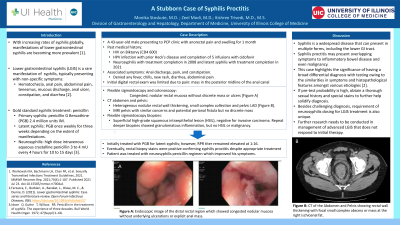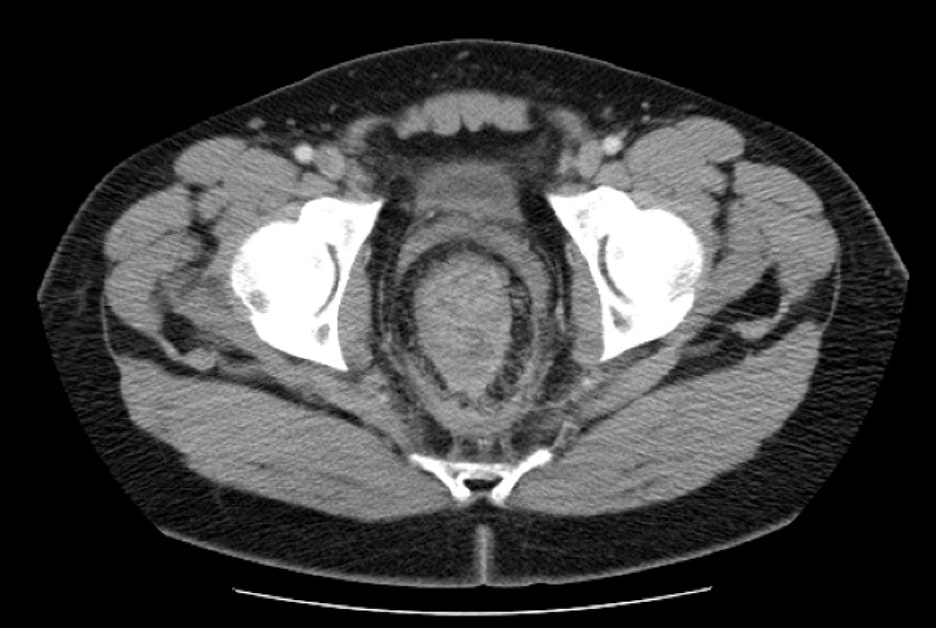Monday Poster Session
Category: Colorectal Cancer Prevention
P2163 - Behind the Symptoms: Unmasking Syphilis Proctitis Through a Unique Care
Monday, October 28, 2024
10:30 AM - 4:00 PM ET
Location: Exhibit Hall E

Has Audio

Monika Stoskute, MD
University of Illinois
Chicago, IL
Presenting Author(s)
Zeel N. Modi, MD, Monika Stoskute, MD, Itishree Trivedi, MD, MS
University of Illinois, Chicago, IL
Introduction: Syphilis, “the great imitator,” has multiple manifestations at various stages of infection, making it a diagnostic challenge. Prompt recognition of the lesser-known syphilis manifestations, such as syphilitic proctitis, is vital in early diagnosis and avoidance of expensive diagnostic workups. We describe a rare case of refractory syphilitic proctitis, misdiagnosed as inflammatory bowel disease, requiring very high, non-standard doses of penicillin treatment.
Case Description/Methods: A 43-year-old male with history of Human Immunodeficiency Virus, chronic orogenital HPV infection including multifocal papilloma, previously treated latent syphilis, and neurosyphilis, presented with acute, severe recto-anal pain, swelling, and constipation. A rectal mass was palpated on the digital rectal exam and a computed tomography of the pelvis revealed marked rectal wall thickening with perirectal fat stranding (Figure A). Exam under anesthesia had an ulcerated rectal mass with pathology showing anal condyloma acuminatum. Colonoscopy revealed a normal appearing ileocolon but had firmness, congestion, and nodular mucosa throughout the rectum without a mass and granulomatous inflammation on pathology. Magnetic Resonance Imaging of the pelvis (MRI) also revealed a bilateral perianal fistula and was evaluated for Crohn’s proctitis. He also had a newly elevated RPR titer of 1:16, despite being treated with 1.2 million units (mU) IM Penicillin G Benzathine (PGB) for latent syphilis. Colonoscopy biopsies sent for spirochete testing with Steiner immunostain were positive and syphilitic proctitis was diagnosed. He was treated with 2.4 mU IM PGB resulting in partial improvement followed with 24mU IV PGB for 14 days for symptomatic resolution.
Discussion: Syphilis proctitis shares similarities with malignancy, IBD, and other infectious etiologies. Syphilitic proctitis is treated with 2.4 mU IM PGB once with a high success rate due to low PGB resistance, but in our case, he developed refractory syphilis proctitis. Per the CDC, any reinfection indicates repeat treatment. However, treatment failure without new infection warrants lumbar puncture for neurosyphilis evaluation since neurosyphilis requires 3 to 4 mU aqueous PGB IV every four hours (or 18 to 24 mU continuous IV) for 14 days. Treatment failure without evidence of concurrent neurosyphilis is still treated with 2.4 mU IM PGB once weekly for 3 doses. This case highlights syphilis proctitis rarity and diagnostic challenges which could result in delayed treatment.

Disclosures:
Zeel N. Modi, MD, Monika Stoskute, MD, Itishree Trivedi, MD, MS. P2163 - Behind the Symptoms: Unmasking Syphilis Proctitis Through a Unique Care, ACG 2024 Annual Scientific Meeting Abstracts. Philadelphia, PA: American College of Gastroenterology.
University of Illinois, Chicago, IL
Introduction: Syphilis, “the great imitator,” has multiple manifestations at various stages of infection, making it a diagnostic challenge. Prompt recognition of the lesser-known syphilis manifestations, such as syphilitic proctitis, is vital in early diagnosis and avoidance of expensive diagnostic workups. We describe a rare case of refractory syphilitic proctitis, misdiagnosed as inflammatory bowel disease, requiring very high, non-standard doses of penicillin treatment.
Case Description/Methods: A 43-year-old male with history of Human Immunodeficiency Virus, chronic orogenital HPV infection including multifocal papilloma, previously treated latent syphilis, and neurosyphilis, presented with acute, severe recto-anal pain, swelling, and constipation. A rectal mass was palpated on the digital rectal exam and a computed tomography of the pelvis revealed marked rectal wall thickening with perirectal fat stranding (Figure A). Exam under anesthesia had an ulcerated rectal mass with pathology showing anal condyloma acuminatum. Colonoscopy revealed a normal appearing ileocolon but had firmness, congestion, and nodular mucosa throughout the rectum without a mass and granulomatous inflammation on pathology. Magnetic Resonance Imaging of the pelvis (MRI) also revealed a bilateral perianal fistula and was evaluated for Crohn’s proctitis. He also had a newly elevated RPR titer of 1:16, despite being treated with 1.2 million units (mU) IM Penicillin G Benzathine (PGB) for latent syphilis. Colonoscopy biopsies sent for spirochete testing with Steiner immunostain were positive and syphilitic proctitis was diagnosed. He was treated with 2.4 mU IM PGB resulting in partial improvement followed with 24mU IV PGB for 14 days for symptomatic resolution.
Discussion: Syphilis proctitis shares similarities with malignancy, IBD, and other infectious etiologies. Syphilitic proctitis is treated with 2.4 mU IM PGB once with a high success rate due to low PGB resistance, but in our case, he developed refractory syphilis proctitis. Per the CDC, any reinfection indicates repeat treatment. However, treatment failure without new infection warrants lumbar puncture for neurosyphilis evaluation since neurosyphilis requires 3 to 4 mU aqueous PGB IV every four hours (or 18 to 24 mU continuous IV) for 14 days. Treatment failure without evidence of concurrent neurosyphilis is still treated with 2.4 mU IM PGB once weekly for 3 doses. This case highlights syphilis proctitis rarity and diagnostic challenges which could result in delayed treatment.

Figure: CT of the abdomen/pelvis showing rectal wall thickening which could be compatible with infectious etiologies or malignancy
Disclosures:
Zeel Modi indicated no relevant financial relationships.
Monika Stoskute indicated no relevant financial relationships.
Itishree Trivedi indicated no relevant financial relationships.
Zeel N. Modi, MD, Monika Stoskute, MD, Itishree Trivedi, MD, MS. P2163 - Behind the Symptoms: Unmasking Syphilis Proctitis Through a Unique Care, ACG 2024 Annual Scientific Meeting Abstracts. Philadelphia, PA: American College of Gastroenterology.
